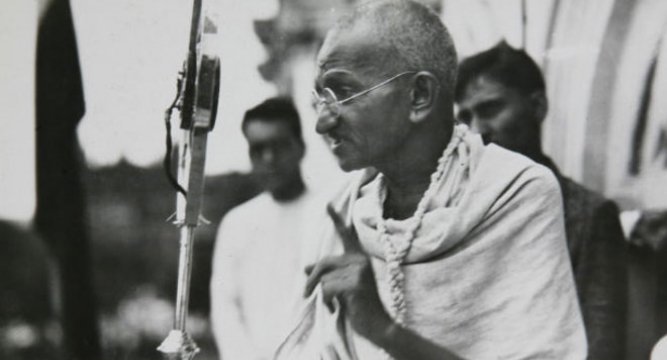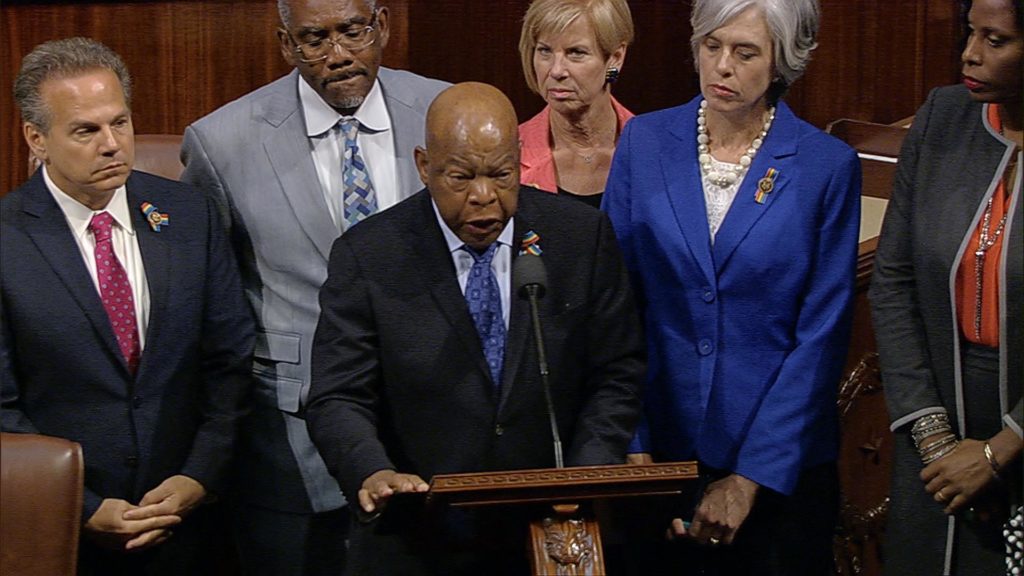Grasping the Reality of Nonviolence
The Background:
With a rainbow pin on his lapel, signifying–on that day at least–the most recent gun massacre in the United States, Congressman John Lewis made an impassioned cri de coeur before members of Congress and the people of this country: the time for silence is over. “Sometimes,” he said, “you have to do something out of the ordinary.” And that’s just what they did: he and other members of his party put their bodies in the way of the daily operations of the Congress, by using a nonviolent tactic known as a sit-in–when you occupy a space in order to dramatize an unmet need; in this case, the need to do something for gun control on behalf of the American people who put them in office to strengthen their common security. While the Speaker of the House had the C-Span cameras turned off, in an effort to censor what was taking place–knowing the power of the media–others whipped out their phones, sent a live-feed to Periscope, and C-Span picked it up anyway. It was “out of the ordinary,” indeed. It was the first time an event of this scale had taken place in the U.S. Congress. Lewis himself, of course, is a legendary Civil Rights-era nonviolent activist. He knows perhaps a little more about nonviolence, from first-hand experience, than just about any of his colleagues, to say the least, if not many of us watching. After 26 hours, the congresspeople end the sit-in, and Congressman Lewis claims it as a victory.
Enter the media. What just happened? And this is the problem. Our media–most of them, at least–can give us the sordid, often insignificant details of a violent event, to the point of having us live and re-live the trauma. But our media does not tell us how to stop such events from happening. In other words, when it comes to understanding nonviolence, its principles and strategic dynamics, our media is sorely lacking. The way that the mass-media, and even progressives on social media, represent what took place can give us insight into some myths held about nonviolence, and offer a teaching moment to go deeper. Because if nonviolence were better understood, we’d quickly grasp that it makes us safer than guns any day. As father of the Catholic Worker Movement, Peter Maurin said, “we need to build a society where it is easier for people to be good.” Nonviolence, properly understood, even just slightly so, can do just that.
Gandhi coined a term for nonviolent struggle: satyagraha. It means “grasping to reality.” Imagine if our media could help us to that. In this spirit, then, let’s ever so briefly glance at what the media has gotten wrong about this event so we can better understand it and in the process elevate another story about who we are and what makes us safe:
Myth One: You can’t be angry and be nonviolent.
Reality: When we listen to Lewis’s speech, it confronts a very basic assumption that has to be overcome about the source of nonviolent power: Anger. He’s angry, no doubt about it, but he knows a secret about that anger: how to use it: to transform and channel it toward constructive action. As Martin Luther King famously said, “We did not cause outbursts of anger; we harnessed anger under discipline for maximum effect.” Remember this the next time you feel angry at injustice: make it work for–not against–you. It’s good fuel when coupled with discernment and discipline.
Myth Two: You have to dislike/hate/disassociate from your opponents.
Reality: Corporate media, and progressive media for that matter, have both made statements to the effect of Lewis breaking his friendship with House Speaker Ryan, with whom he even walked on the Edmund Pettus Bridge to honor the famous 1965 march in Selma. One article that circulated in several corporate outlets offered a sad (and sadly incorrect) analysis that Lewis used to be on Ryan’s side but now with this sit-in, it seems that those days are over. Not true. In nonviolence, we can oppose people, even our friends and colleagues, and not feel separate from them. We don’t have to hate someone to oppose what they are doing. Let’s make that clear once and for all. Secondly, the media is setting up that infamous dualism that pervades every story, every movie, every news plot about anything from sports to political rivals to terrorism: good guys vs. bad guys. There are not good and bad people. There are people who make choices based on information and constraints that they have personally and politically. Nonviolence can help cut through all of it and get to the heart of the matter. Never are we against persons, we are against what people do. There’s a critical difference.
Myth Three: If you don’t get what you want, your nonviolence didn’t work.
Reality: It’s interesting that no one yet has really analyzed the strangeness of Congressman Lewis’s declaration of victory. How could they “win” if they didn’t get what they wanted? They were not granted a vote, after all, so what happened? Michael Nagler’s concept of “work” vs. work sheds light on this one: sometimes in nonviolence, you get what you want, and it works; and sometimes you don’t get what you want, and it still works. Whenever we use nonviolence, we inject positive, humanizing energy into a situation of escalating dehumanization, and every ounce of that nonviolent energy does constructive work. It is not lost. Ever. One of Gandhi’s biographers, the late B.R. Nanda, put it this way, “nonviolence is the kind of thing where you can lose all of the battles and still go on to win the war.” Not to mention, it’s entirely good strategy to claim real victories, however small, as they take place, and even more strategic to do so without humiliating those whose actions you are opposing.
Myth Four: Nonviolence does not have any logic. It’s signing petitions and sit-ins. Nothing else.
Reality: Again, not true. Congressman Lewis demonstrated that there is a natural escalation to nonviolent action. This is described on page 108 of Nagler’s Search for a Nonviolent Future with a nonviolent conflict escalation curve. Open that book. It matters. In Phase One of a conflict when the dehumanizing is still low, you reach for the basic, and well-known tools of conflict resolution. This is the time for petitions, for meetings, for letter writing, mediation. And this is necessary. You start here, assuming your opponents are listening to you — and you are listening to them. You’re all prepared to work on a solution, however hard it might be. But when it is signaled that your opponent is not listening to you, when dehumanization escalates, nonviolence has to do the same. This is Phase Two: satyagraha, creative nonviolent action that puts ourselves in the way of the operation of society as normal. No more signing Change.org petitions on gun legislation: now we have to stop the functioning of Congress itself for 26 hours. Which brings up another point: nonviolence can happen from any direction–not just the grassroots, but from leaders and politicians. It’s our birthright, no matter where we are in life.
Myth Five: Either you’re nonviolent or you are not. And if you’re not, you’ll never get there, so don’t even try.
Reality: Even though Congressman Lewis has an admirable track record for nonviolent action, being literally an icon of the most famous nonviolent movement in the United States, from going on the Freedom Rides to acting as a key leader of the Student Nonviolent Coordinating Committee (SNCC), a lifetime champion of civil rights in general, he was surrounded by colleagues–and a public–whose lives have been very different. But nonviolence is not reserved for a Congressman Lewis alone. It’s an invitation to all of us. No matter where we’ve been on issues in the past, we can change. In fact, if we do not allow each other to change, or humiliate people until they do, we have to ask ourselves if we are making a strategically sound choice that will create a tipping point or if it will only harden people’s stance? Allowing each other our full humanity means giving all of us, no matter what we’ve done in the past, no matter what choices we’ve made, a chance to live up to something else. No one heard a word of humiliation from Lewis. We can learn something from him on this point. It’s intentional and strategic, not merely a moral choice, because nonviolence at the end of the day is not a moral issue; it’s not black and white: it’s the art of justice with dignity, a science of belonging, of the untapped human capacity for mercy.
*
Gandhi’s own cri de coeur resounds now through the decades since his great experiments: “Nonviolence is not the inanity it has been taken for throughout the ages.” It’s a science; it’s a skill–and it’s time that we learned everything we can about it, because nothing else is going to make this country secure. For those of us who want the world that Congressman Lewis and his colleagues sat down for, let’s seize this opportunity to end the silence, too, and tell the real story behind his words and actions on the floor of Congress last week.

This article was syndicated by Peace Voice.











Thank you Stephanie for this insightful article. I think it’s very important to clarify some of those myths on nonviolence. One arguest I’ve heard is, because the bills Democrats are trying to get voted on ate not good enough, they sort of wasted the energy. In other words, they used the right means to advance not so right ends. What do you think about that?
Hey Anna, certainly what they were going for was not enough and somewhat problematic, but I think that it does two things. 1. Makes us think about strategy. What would it take to pass any gun legislation in the congress? and 2. Who gets to use nonviolence and for what? Reminds me of that question you asked in your presentation to Carnegie…
xo
Thank you! Yes, definitely, and the who gets to use nonviolence part is very interesting to me. No easy answers. Sorry about the typos, by the way…
[…] Van Hook Published in: Grassroots Press, Waging Nonviolence, Counterpunch, Metta Center for Nonviolence Date: June 26,27,28,2016 1465 […]